In the late 1930s, electric lines began to appear in some rural neighborhoods of North Dakota. Co-ops formed, signed on members, and applied for Rural Electrification Administration (REA) loans. Perhaps it wasn’t quite that simple, but most rural residents agreed that electricity was worth more than the problems they had to solve along the way.
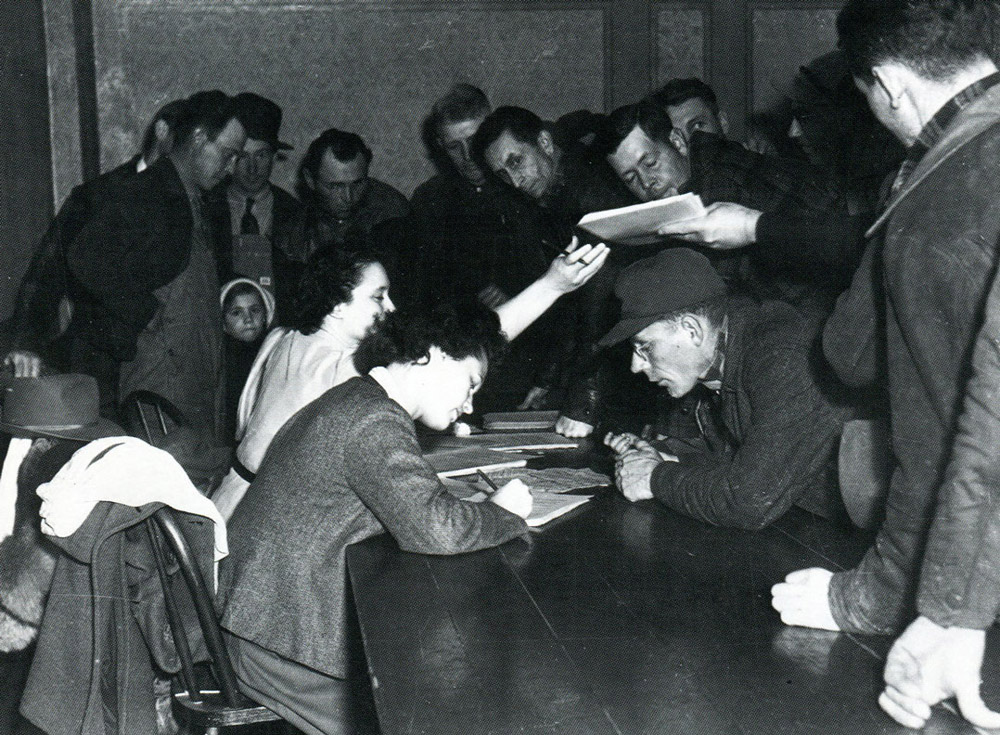
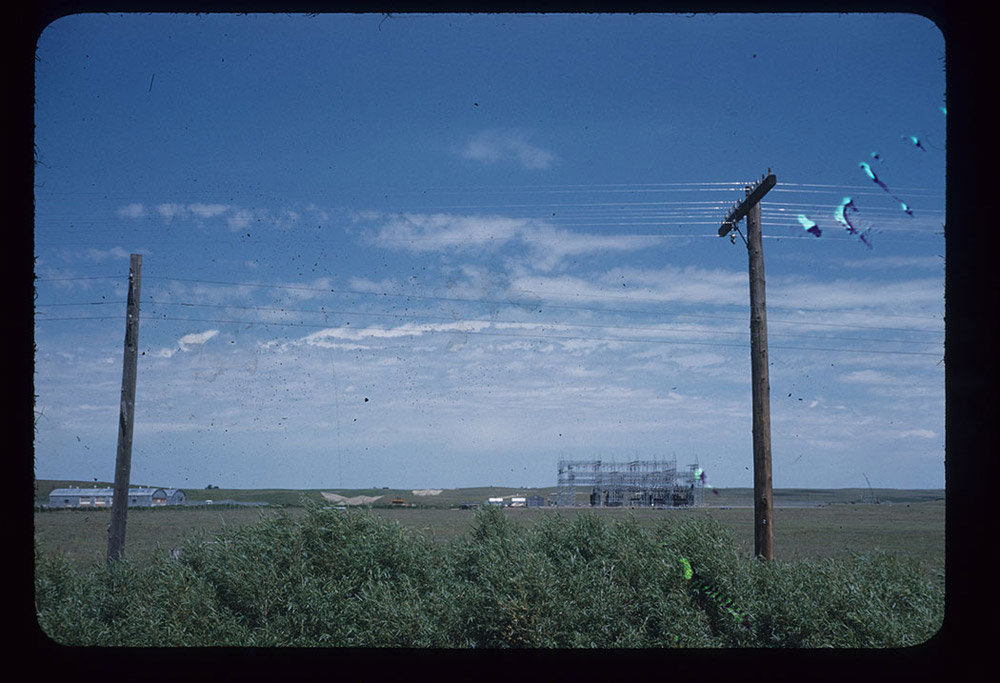
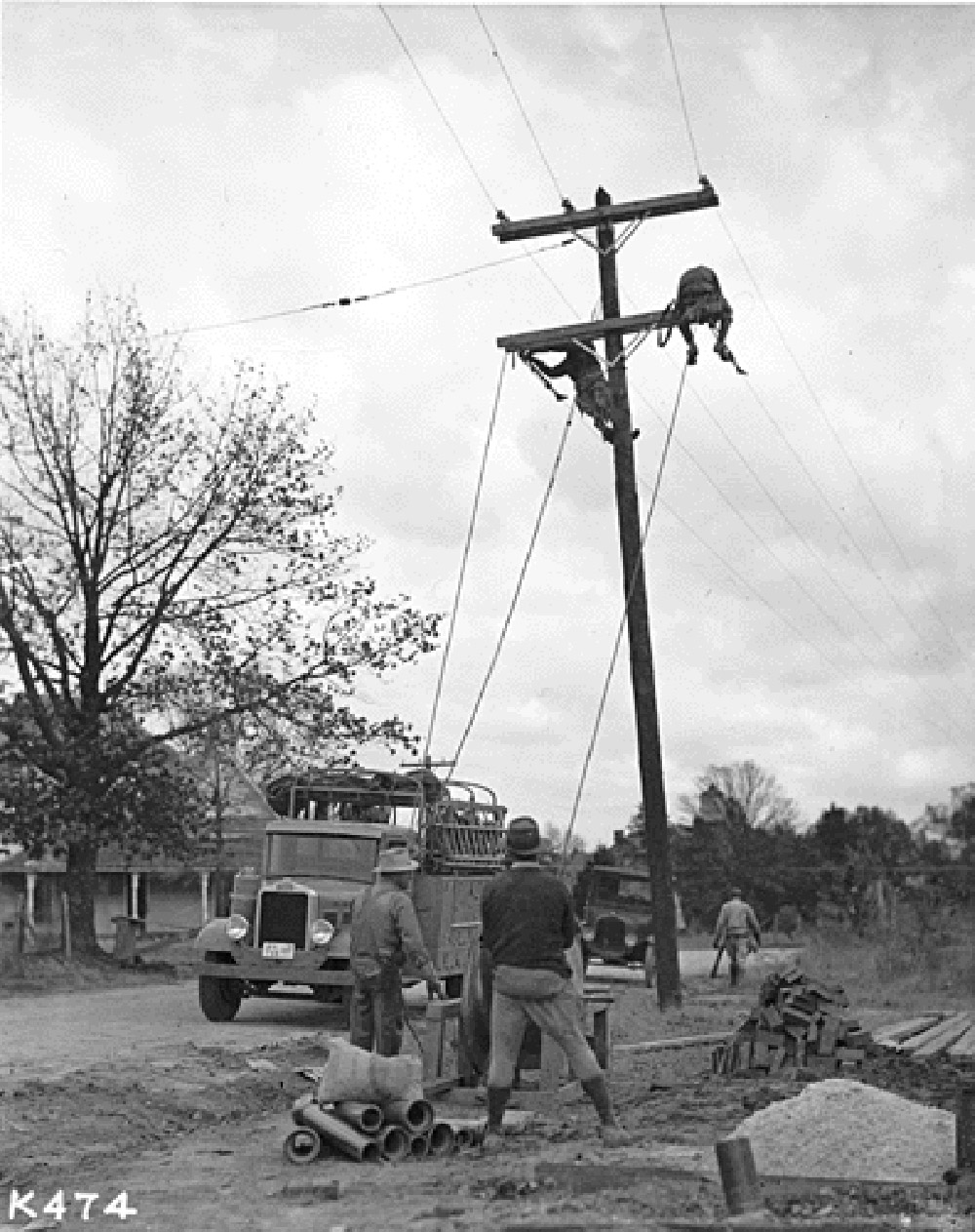
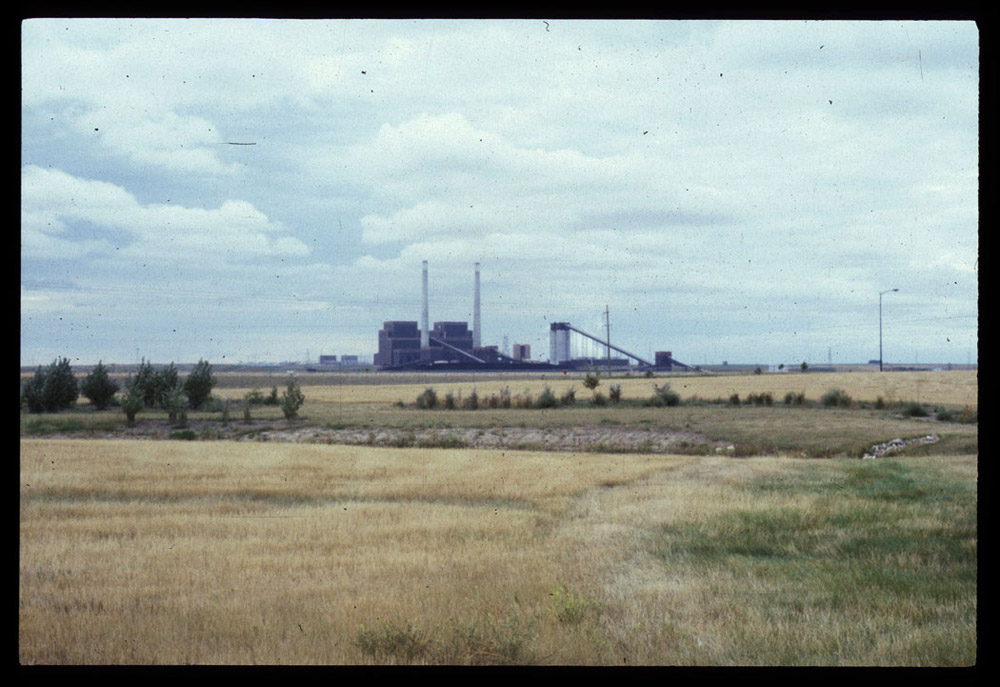
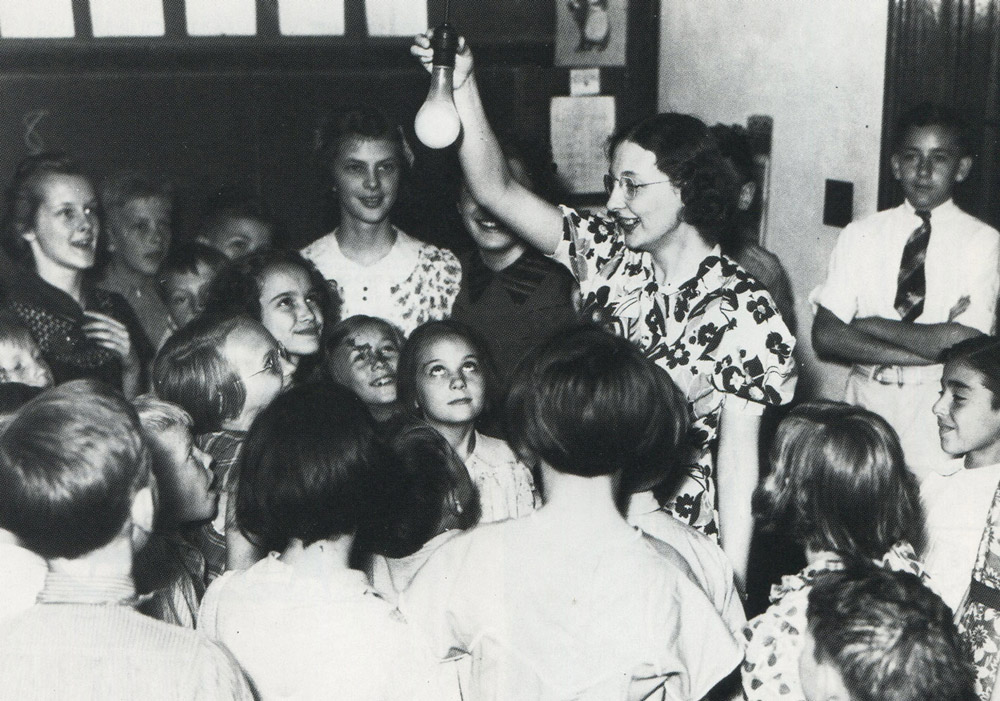
The co-ops had to sign up members. (See Image 8.) The initial sign-up fee was $5.00 (more than $80 today), and farmers would have to pay a minimum charge of $3.50 each month for electricity. After the uncertainties of the Great Depression, some farmers were reluctant to make the commitment to the local electric co-op. However, most farm women had no doubt that they wanted electricity to make their household chores easier. Every household chore could be made more efficient and effective with electricity. The most important single advantage inside the farm home was an electric pump to bring water into the home. Indoor bathrooms were a great improvement in family comfort and health. Women who had a ready supply of water for cooking, cleaning, and bathing could keep their children clean and healthy.
Co-ops had to get farmers to give up some land for the power lines. (See Image 9.) Some farmers were reluctant to do so, but the power co-op usually did not force compliance; they just moved the line. Farmers usually granted the easement for power lines because it meant getting power to their own homes.
The co-ops purchased their own supplies and hauled them by train to a location near the building site. Sometimes, the co-ops anticipated the REA loan and made their purchases before the loan money arrived. They covered their bills with local bank loans or with personal funds.
Farmers took to heart their role as member-owners of the electric lines. Many helped build the lines by using shovels and their own hard labor to dig holes for the poles. They often raised the poles into position with hand-held lines. (See Image 10.) The farmers’ labor moved construction along quickly.
As the rural electric co-ops prepared to distribute electricity along their lines, they first had to purchase power at a wholesale price from electricThe electric co-operatives have also led to the development of other services in the cooperative model. For instance, National Information Solutions Cooperative of Mandan provides billing and accounting services to more than 700 energy and telecommunications members in the United States and Canada. The co-op has nearly 1,000 employees at offices in four states. generation and transmission co-operatives. The co-ops then sold electricity to their customers at a price determined by the co-op’s member-elected board of directors. (See Image 11.)
The first co-op to go “on line” was the Baker Electric Cooperative, headquartered in Cando. (See Image 12.) Baker’s members received electricity on November 24, 1937. (See Document 1.) Twelve years later, the last rural co-op began sending electricity through its lines. (See Map 1.)
Document 1. The Day the Lights Came On
Many people remember the first time they had electricity in their homes. It made such a difference in their workload and in the home lighting. School houses were electrified, too. Country schools were often built with a bank of windows on the south side to capture sunlight. With REA, classrooms were light even on dark and gloomy days.
Families prepared for electric lighting by installing wiring, sockets, and light fixtures. They purchased stoves, refrigerators, and plumbed their sinks for pressurized water through the tap. None of these could be used until the great day when the switch was thrown by the co-op manager to release the power into the lines. They had planned and prepared, and many were excited about what they could see with electricity.
Lois DeFord: “As I recall, the day was cold and gloomy in early January 1948. . . How well I remember ‘the day the lights came on.’ The choice of our farm [for the celebration of electrical service] was indeed a great source of pride for my father, Carl Rummel, who was a director of West Plains Electric Co-op [near Richardton] at the time. Our farm was close to the first substation and it was fully wired, a rarity for a farm in those days. . . We girls went off to school–kids didn’t stay home for such things in those days. As we left, Mom was busy cooking up food to feed the dignitaries, and Dad was grinning and pacing. . . [When school let out, the day was overcast] cloudy and dark enough that we could see LIGHT in the house as the school bus turned off the highway. What a glorious feeling!”
Jo Vilhauer: [When the lights came on, my mother, Lena Kaiser, exclaimed] “‘Ach! Sind die Wände gelb!’ [Oh! The walls are yellow!] Mom had already purchased a new white electric stove and white sink. In Mom’s eyes the kitchen had to be painted white also. You couldn’t tell before of course, with the dim kerosene light. Needless to say, in short order the kitchen was repainted white.”
Eunice Kost: [In 1947, the Kosts built a new farm home, but could not move in until McLean Electric Cooperative began supplying power. The old farm home was heated by coal and was] “so cold the dipper froze into the ice in the drinking water pail- the dish where we washed our hands was frozen solid, and even the slop pail froze. So would you wonder why I cried when the electricity came on and we could move into a new home with electric lights and look forward to lights and warmth? I remember putting my first tomato and cucumber in the refrigerator so it looked pretty when the door was open. I thought I was in seventh heaven! . . . No price tag could be put on REA. City people used to look down on farmers because of the outhouse and lack of conveniences, but now most farm houses have every convenience available. And who could be more deserving than a hard-working farm wife?”
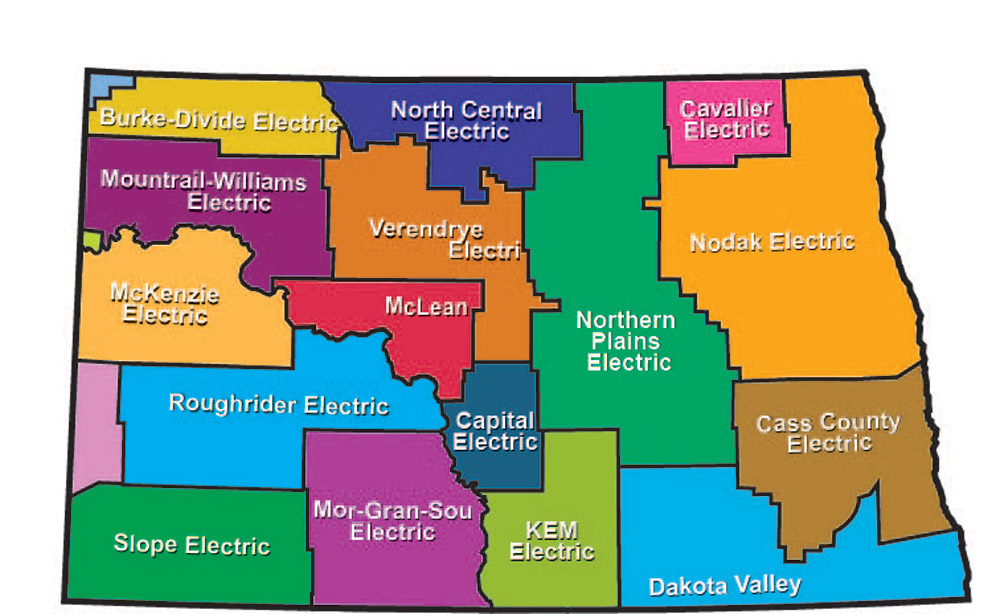
Since the co-ops first sent electricity along rural lines, several of the co-ops have merged.The Baker Electric Cooperative merged in 1996 with the Tri-County Electric Cooperative (Carrington) to form Northern Plains Electric Cooperative. Northern Plains covers more territory than any other co-op in North Dakota. Northern Plains maintains 6,900 miles of electric line and serves customers from the Canadian border to an area south of Jamestown. There are now 18 rural electric co-operatives in North Dakota. Some electric co-ops also serve cities or portions of cities. (See Document 2.)
Document 2. The Cooperatives
Recently, three executives discussed their experiences and philosophies in working with electrical cooperatives. They all believe that the history of cooperatives contributes to the continuing success of North Dakota’s rural electrical cooperatives.
The cooperatives that supply electricity to members’ homes are called distributive co-ops. Generation and transmission cooperatives provide power and lines to the distributive co-ops. Basin Electric generates power for member cooperatives in nine states. National Information Solutions Cooperative provides business services to electrical co-ops in several states. It is headquartered in Mandan, North Dakota.
Gary Williamson, retired manager, Central Power Generation and Transmission, Minot (Mr. Williamson was interviewed in September 2013)
“Consumer ownership is a strong, strong, thread that held the cooperatives together. . . I heard from many people about those early days. . . . I was talking to the son of one of my directors and he was recalling and telling us how he literally dug the holes so they could get the power into their homes and they didn’t have any power. . . . People could look and see the lights of the city and they didn’t have any and they wanted it so badly that they took it upon themselves to build a rural electric program. I think the cooperative model is as strong a free enterprise product and model that you can get. It is consumer owned and controlled by the board of directors they elect. If they’ve got a complaint, they don’t need to stand in line and try to see somebody, they go to their director – at the coffee shop in town or at the annual meetings. I think consumer ownership is such a strong, strong fiber that holds them together.
“Back in those days. . . .I would hear stories about how directors would go to Washington, D.C., to try to get loan funds or to protect a program against a tax. They would get on the train and spend days. Today we can get there in two hours. But that’s the way they did it and they took their business directly to Washington. One story I heard from Helge Nygren, who was the former president of our statewide association and director out at Mor-Gran-Sou [Electric Cooperative] . . . [He went to Washington, D.C. to testify in the Senate.] Senator Humphrey said, ‘Well, everyone else can submit their testimony to the committee clerk and we will take it into consideration.’ Helge jumped up and said, ‘I didn’t ride 2,000 miles to have you tell me that I couldn’t talk.’ That’s the type of people that built this program. And they haven’t stopped doing it.”
“These guys in those early days- they really knew how to network. They might not have had the instant communications and the cell phones and iPads and that, but they were on the phone, they were out in their cars driving to meetings, and politicking. The rural electric program was born in politics and it has stayed alive in politics and it will never die either because of politics because these people have a mission. They do more than electricity. They are part of the community. New innovation, the distribution cooperatives, a lot of them have a program where they round off the bill for the consumers. The consumers vote on this at their annual meeting and they take that money and provide ambulance service and they donate to their community. You will find many coop employees that are very actively involved in their community. . . I think this is one of the greatest strengths that the rural electrics have brought to this state.”
Ron Harper, retired Chief Executive Officer, Basin Electric (Mr. Harper was interviewed January 2014)
“That cooperative business model is one that is beneficial to the people that own it and to the people it serves and so on. And having had the opportunity to know what it’s like to lay an underground conductor and accounting and engineering and construction – all those things come about in helping an individual understand what it takes to make a team, to make a cooperative work. It’s not just one individual, it is a group of individuals that help make everything successful.
“And had it not been for those rural farmers and others to get together and say, “enough is enough,” we need to build our own system, rural North Dakota would not have developed to the magnitude that it has. And I think as you look at the generation and transmission cooperatives that built the transmission line, that ultimately built the generating units, the Leland Olds Station for instance, it would have been extremely difficult to imagine where North Dakota would be today.”
“I’ve always argued that the farming mentality is what made it work because there’s a stubbornness there that says. ‘don’t tell me I can’t do it. I’ll find the right people and the tools to get it done.’ And that’s exactly what the cooperatives have done.
Vern Dosch, President and CEO, National Information Solutions Cooperative (NISC) (Mr. Dosch was interviewed December 2013)
“I’ve had the good fortune to work in this industry from literally two days out of the university. Looking over my shoulder that’s about 38 years, but before that, I grew up in Bismarck and spent the summers working on the farm in Strasburg. That’s where my family came from. My grandfather was Sebastian Dosch who was one of those proverbial people we have talked about in this industry who went from farm to farm collecting five dollars to start KEM Electric. He was one of the original incorporators of KEM Electric. It was somewhat by chance that I had the opportunity right out of college to work for Capital Electric. It was always a big deal to my grandfather when I would see him. He lived until he was 92, but every time I would see him, he would ask ‘How’s the coop doing?
NISC was actually formed in July of 2000 and really became at that point a national provider, so I’ve [watched this] organization grow from 30-some employees to almost a thousand, servicing almost 700 utilities in 38 states and American Samoa, Guam and Canada. Probably more importantly I’ve had the opportunity to watch North Dakota kids from off the farm with their degrees come to work in their field right here in North Dakota and develop products that literally are spread all across the country now."
Why is this important? We often use electricity in our daily lives without giving it much thought. However, since electrification, our houses depend on electricity for heat, lights, cooking, hot water, and even the pump that brings water into the house. On farms, electricity also lights barns, powers machinery and tools, and brings water to livestock. In recent years, farmers have come to depend on cell phones and computers which need electricity for operation or re-charging.
Before electricity was available in rural North Dakota, people managed all daily operations without electrical power, but the systems they depended on are no longer available. Though some people have developed other sources of electricity such as solar or wind power, most North Dakotans depend on electrical power purchased from large generating plants.


